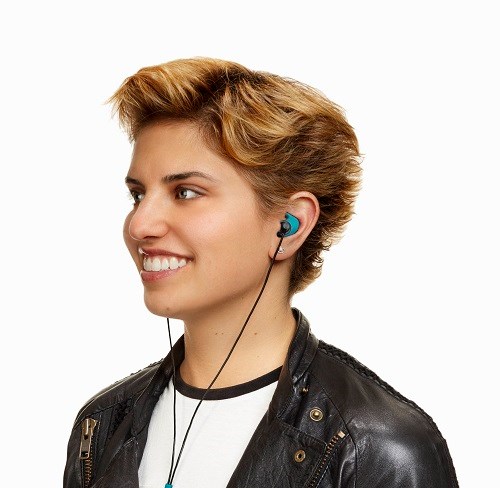Additive Manufacturing Is the New ‘Normal’
One of the first companies founded on the principle of individualized manufacturing puts AM to work right out front in its retail lobby.

Normal founder Nikki Kaufman, wearing her product.
Leaders of large and small businesses are constantly asking the question of how to attract young talent to careers in industry: How do we make manufacturing ‘cool’ again?
Nikki Kaufman has found an answer. Her brand-new company, which launched just last July, has a cool, intriguing name, Normal. It’s located in the hip, artsy Chelsea district of Manhattan’s West Side. Her company makes a product desired by almost any user of a smart phone or digital music player. And Normal makes the product better, faster, and cheaper than anyone else in the world by using the newest, “greenest,” and, some might say, coolest industrial technology—3D printing.
Kaufman, 29, started her company out of a quest for earphones that aren’t uncomfortable to wear for extended periods. She tried dozens of commercial earbuds without success and considered having a custom pair made. But she learned that would involve a visit to a doctor’s office, would take three to six weeks, and cost up to $2000. She decided she could do better on her own.
Last summer, Kaufman launched her brainchild based on the idea of making custom earbuds with a personalized fit in as little as 48 hr and for $199, including shipping and tax. And all you need is a free iTunes or Android app that walks you through steps of photographing your ears, choosing among several color options, and ordering the earphones.
And about her company’s name: “What is a normal ear shape? There’s no such thing. Everyone’s is different,” Kaufman explains. “Even your left and right ears can differ by up to 20%.”

Kaufman in front of two of her 10 Stratasts 3D printers.
Normal has joined the small handful of companies today (apart from service bureaus) whose business model is based on making proprietary products with additive manufacturing, or 3D printing as it’s commonly known. Standing in the store, you probably won’t immediately notice (this reporter didn’t) that you’re also in the factory area. Set flush into the walls are eight Fortus 250mc 3D printers from Stratasys, Ltd., Eden Prairie, Minn. There are two more of these printers on another floor, along with two Stratasys smoothing stations, two paint booths, two cleaning stations, and one laser cutter.
The 3D printers use the Fused Deposition Modeling (FDM) technology, which extrudes fine molten strands of thermoplastic—ABS, in this case—in thin layers according to a “sliced” CAD model of the part.
FDM is used to produce the earpiece that fits your ear cavity. Seven colors are available. It is soft-touch coated and assembled with a handful of purchased components, including an injection molded and UV-coated ABS/PC “inner cabinet,” the 14-mm audio speaker, CNC anodized aluminum “outer cabinet,” a brass tube, coaxial connector, and 360° rotating CNC anodized aluminum cable housing.
Normal has another use for FDM—to make tools like jigs and fixtures for its own internal manufacturing needs. That’s in line with what Stratasys CEO David Reis sees as the main near-term market opportunity for FDM—jigs, fixtures, and molds, also referred to as “augmented manufacturing”—rather than “direct digital manufacturing” (DDM) of end products, as Normal is doing.
(More details on Normal’s use of FDM will appear in a special supplement on Additive Manufacturing to accompany the February issues of Plastics Technology, MoldMaking Technology, and Modern Machine Shop magazines.)
Related Content
Formulating LLDPE/LDPE Blends For Abuse–Resistant Blown Film
A new study shows how the type and amount of LDPE in blends with LLDPE affect the processing and strength/toughness properties of blown film. Data are shown for both LDPE-rich and LLDPE-rich blends.
Read MoreHow to Optimize Injection Molding of PHA and PHA/PLA Blends
Here are processing guidelines aimed at both getting the PHA resin into the process without degrading it, and reducing residence time at melt temperatures.
Read MoreBest Methods of Molding Undercuts
Producing plastics parts with undercuts presents distinct challenges for molders.
Read MoreHow to Extrusion Blow Mold PHA/PLA Blends
You need to pay attention to the inherent characteristics of biopolymers PHA/PLA materials when setting process parameters to realize better and more consistent outcomes.
Read MoreRead Next
People 4.0 – How to Get Buy-In from Your Staff for Industry 4.0 Systems
Implementing a production monitoring system as the foundation of a ‘smart factory’ is about integrating people with new technology as much as it is about integrating machines and computers. Here are tips from a company that has gone through the process.
Read MoreTroubleshooting Screw and Barrel Wear in Extrusion
Extruder screws and barrels will wear over time. If you are seeing a reduction in specific rate and higher discharge temperatures, wear is the likely culprit.
Read MoreProcessor Turns to AI to Help Keep Machines Humming
At captive processor McConkey, a new generation of artificial intelligence models, highlighted by ChatGPT, is helping it wade through the shortage of skilled labor and keep its production lines churning out good parts.
Read More















.png;maxWidth=300;quality=90)










